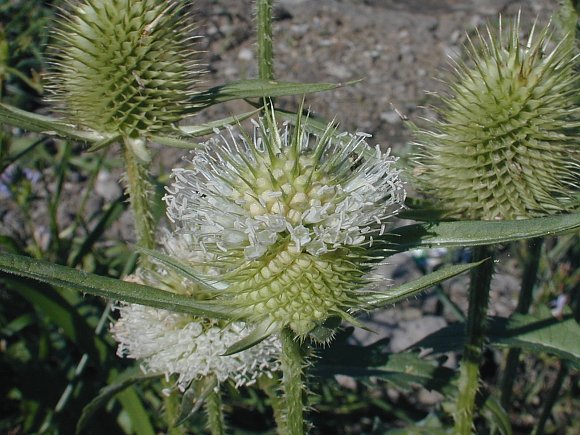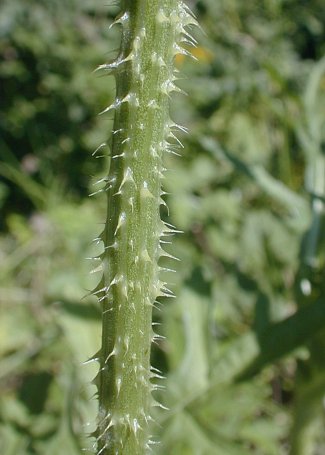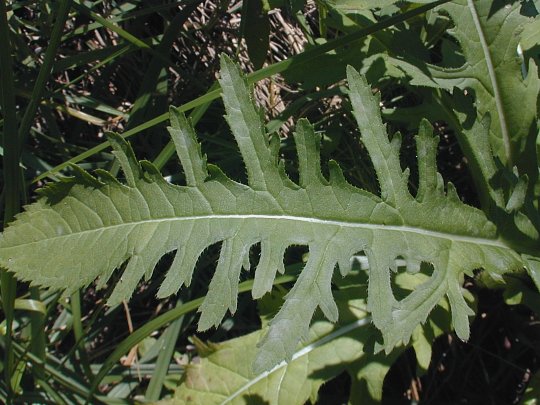Description: This is a biennial plant. During the 1st year of development, it consists of a rosette of basal leaves about 1–2¾' across. These basal leaves are up to 16" long and 4" across. They are lanceolate or narrowly ovate in outline, but their margins are pinnately lobed (pinnatifid), coarsely toothed, and ciliate. During the 2nd year of development, one or more tall flowering stalks emerge from the basal rosette that are 2-6' tall. These stalks are stout, round or angular, and covered with white prickles. There are opposite leaves at intervals along the lower half of the stalks. These opposite leaves are smaller in size and have shallower lobes than the basal leaves, otherwise they are much the same. Their bases are perfoliate or strongly clasp the stalks.

Each stalk
terminates in a cylindrical flowerhead about 2-4" long and 1½" across.
At the base of this flowerhead are several long bracts about 2-4" long
that taper to a sharp point. They are folded along the middle and have
small prickles underneath. These bracts are more or less straight and
spread outward from the base of the flowerhead, rather than curling
upward. The flowers are densely packed together all around the
flowerheads. Each flower has a single bractlet about ¾" long at its
base that tapers to sharp straight point. These bractlets are longer
and more conspicuous than the flowers. The corolla of each flower is
narrowly tubular and about ½" long, flaring outward slightly at its
apex into 4 small petals. This corolla is usually white rather than
lavender. There are 4 stamens with white anthers that are exerted from
the corolla tube. The calyx of each flower is small and inconspicuous.
A wreath of flowers are in bloom together around the flowerhead,
beginning at the bottom and gradually ascending to the top. The
blooming period occurs from
mid-summer to early fall, and lasts about 1-2 months for a colony of
plants. The flowers are often fragrant. Each flower is
replaced by an
oblong seed that is 4-angled; it is truncate on one end and rounded on
the other. The root system consists of a stout taproot. This plant
spreads by reseeding itself, and it occasionally forms colonies.
fragrant. Each flower is
replaced by an
oblong seed that is 4-angled; it is truncate on one end and rounded on
the other. The root system consists of a stout taproot. This plant
spreads by reseeding itself, and it occasionally forms colonies.
Cultivation:
The preference is full or partial sun, mesic conditions, and fertile
loamy soil. This plant will grow in poor soil, but its size will be
reduced. During a hot summer drought, some of the lower leaves may turn
yellow and fade away, otherwise this plant has few problems. It is
often aggressive and hard to get rid off. Digging the plants out with a
shovel helps, but the portion of taproot remaining in the ground may
regenerate a new plant. Cutting off the flowerheads with a knife while
leaving the rest of plant undisturbed is not adequate as a method of
control, because Teasel is often strong enough to produce new flowering
stalks.
Range & Habitat:
Cut-Leaved Teasel has been observed primarily in NE and central
Illinois, where it is occasional to locally common (see Distribution
Map).
This species is
undoubtedly still spreading across the state. It was introduced into
the United States from Europe as a horticultural plant. Habitats
include mesic cemetery prairies, savannas, roadsides, weedy meadows
along rivers, pastures, and waste areas. Teasel is sometimes found
around cemeteries because wreaths for the deceased were made from the
flowering stalks. While Cut-Leaved Teasel is normally found in
disturbed areas, it also invades high quality natural areas and can
become a serious pest.
Faunal Associations:
The flowers attract bumblebees, bee flies, butterflies, and skippers.
Insects with shorter mouthparts have trouble reaching the nectar. Some
Halictid bees may visit the flowers to collect pollen. Mammalian
herbivores shun Cut-Leaved Teasel as a food source because the foliage
and flowerheads are quite coarse and prickly. In overgrazed pastures
where there is little else for cattle to eat, this is one of the few
plants that is left standing.
Photographic Location:
An area of Judge Webber Park in Urbana, Illinois, that was subjected to
disturbance from construction equipment.

Comments: Species of Teasel have very unique flowerheads that are quite prickly because of the bractlets of the flowers. During the rosette stage, they resemble some Lactuca spp. (Wild Lettuce), but become quite different in appearance after the flowering stalks develop. Cut-Leaved Teasel is similar in appearance to Dipsacus sylvestris (Common Teasel), which also occurs in Illinois. This latter species usually has lavender flowers and its leaves are entire rather than pinnately lobed. The bracts at the base of its flowerheads curl upward, while the same bracts of Cut-Leaved Teasel are straight and spread outward.